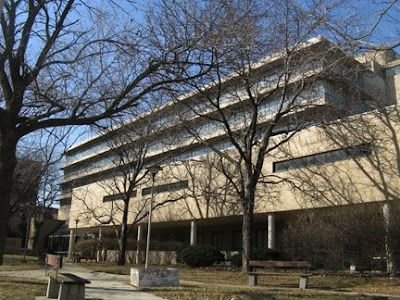Chicago Mayor Richard M. Daley wants to destroy this:

and this:

and this:

and this:

We've
written before about how the rich legacy of Bauhaus inspired architecture on the former Michael Reese Hospital campus is living on knife edge waiting to be sacrificed to the mayor's Olympic vision. Now it's crunch time.
How casually our mayor comes to the international Olympics table in the role as a destroyer of world culture. Let us count the desecrations:
1. A century of Chicago Jewish culture, as embodied in on of its most enduring and important institutions.
2. All manifestations of a critical decision point in Chicago history where, in the mid 20th Century, Michael Reese chose
not to abandon the city, but commited itself to be a key mover in the plan to rescue a desperately troubled south side.
3. Some of the most beautiful landscapes in the city, from the hand of famed designer Hideo Sasaki.
4. Chicago's richest repository of Bauhaus-inspired architecture, a worthy mirror to the Mies van der Rohe designed IIT campus from the same era, in buildings bearing the unmistakable imprint of the involvement of Walter Gropius, one of the most important architects of the 20th century.
Destroy it all, our mayor decrees. Grind it into the dust and leave no trace behind.
And it gets worse.
The
Gropius in Chicago Coalition has already reported that the commemorative plaques - to Gropius, to donors, to the spot where softball was invented at the old Calumet Club - have all disappeared. Now added to the pile is
Pillar, a sculpture by renowned Chicago Afro-American sculptor Richard Hunt, which vanished between June 30th and July 3rd.
Far too heavy and large for amateurs to remove, the sculpture was surely uprooted from the fenced-in site by one of the various contractors. The GCC has been attempting for the last week to locate the sculpture, without luck. At the present time it is considered stolen, and joins several other irreplaceable historic artifacts in this pathetic category. On June 30th, a source at the hospital informed the GCC that demolition contractors had wanted to remove the important Richard Hunt sculpture so that it could be sold as scrap metal. If anyone has any knowledge of the sculpture’s whereabouts, please contact us immediately.
We are told we have no choice but to do this, to provide an athletes' village for the 2016 Olympics. This is, of course, a lie. The Michael Reese location is a very capacious 37-acre site. It would not be hard to strike a balance between preserving Chicago's rich history and supporting a better future.
But our Mayor is desperate. Cities all across America have no alternative but to keep coming up with innovative ways to survive in an often gravely uncertain economy, but at a
July 8th press conference Mayor Richard M. Daley declared he has but one idea - the 2016 Olympics. "This is the only economic engine," said Daley, adding that he has "nothing else up my sleeve."
There is no Plan B. Daley gives us but one choice for securing Chicago's economic future, a choice between stagnation and an Olympics that lasts all of several weeks during one summer seven years away. He's become like the drunk telling his family that their only salvation is, not in his sobering up and getting a grip, but in the lucky lottery ticket he's just purchased.
Specifically, he is desperate to find a developer willing to commit over $1 billion dollars to build the Olympic Village, and he apparently believes if he gives them a clean-as-a- whistle tabula rasa site they'll forget to ask themselves basic questions such as how they'll be able to unload up to 5,000 units after the village is converted to condo's when there were only about 4,400 sold throughout the entire downtown area in the peak year of 2005.
Yes, this is the Chicago of legend - tough as nails, cynically corrupt, where, for those with money and power, anything goes.
That is not my Chicago. It is not the Chicago of the millions of non-insiders who love this city and its history, and see its culture as something to be cherished, not pitched in the nearest dumpster.
Tonight, Tuesday, July 21st, 7:00 p.m., at Olivet Baptist Church, 31st and King Drive, the 4th ward's alderman, Toni Preckwinkle, will join officials from the city and Chicago 2016 in unveiling the grand plan for demolishing Michael Reese. The activists of the Gropius Chicago Coalition will be there, as well, "for a polite showing of support in favor of a more sensitive plan." You're invited, too. You get to declare which Chicago is your Chicago, and probably do it with a lot more grace and diplomacy than I've shown here.
 In a Illinois Medical District campus overwhelmingly populated by four-square structures of deep sobriety:
In a Illinois Medical District campus overwhelmingly populated by four-square structures of deep sobriety: The headquarters for the Medical District Commission at 600 South Hoyne clearly stands out . . .
The headquarters for the Medical District Commission at 600 South Hoyne clearly stands out . . . . . . not only for the distinctive form with a loving nod to classic Rooty-Tooty-Fresh-'N-Fruity design, but for the heightened security provided its executives by the killer rabbit standing guard at the entrance . . .
. . . not only for the distinctive form with a loving nod to classic Rooty-Tooty-Fresh-'N-Fruity design, but for the heightened security provided its executives by the killer rabbit standing guard at the entrance . . .














































